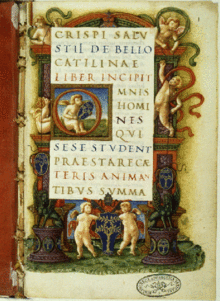The Conspiracy of Catiline
show This article may be expanded with text translated from the corresponding article in Italian. (April 2021) Click [show] for important translation instructions. |
 Illuminated frontispiece of a manuscript copy of The Conspiracy of Catiline made by Bartolomeo San Vito for Bernardo Bembo in 1471–84, now kept in the Vatican Library | |
| Author | Sallust |
|---|---|
| Original title | De Catilinae coniuratione |
| Language | Latin |
Publication date | c. 43–40 BC |
The Conspiracy of Catiline, also known as The War of Catiline, (Latin: De coniuratione Catilinae or Bellum Catilinae) is the first history published by the Roman historian Sallust. The second historical monograph in Latin literature,[1] it chronicles the attempted overthrow of the government by the bankrupt aristocrat Catiline in 63 BC in what has been usually called the Catiline conspiracy or Second Catilinarian conspiracy.
The Conspiracy of Cataline became a symbolic representation of the moral and social decadence of the ruling Roman classes, particularly the Roman Senate, during the 1st century AD. Sallust continually critiques Roman corruption throughout his narration.
Summary[]
The history begins with a brief preface on the nature of man, history, and a brief autobiography of Sallust himself. Afterwards, Sallust launches into a character description of Catiline, who is portrayed as at once heroic and immoral, and then a description of Catiline's intention to gain kingship at any cost. However, Sallust tells his readership that Catiline's political ambitions were thwarted several times in his youth, and perhaps alludes to the First Catilinarian conspiracy, and he finally resorts to rebellion, during which attempts to recruit a number of bankrupt nobles and politically dissatisfied plebeians. The Senate eventually discovers the conspiracy, and attempts to put it down militarily. In the one and only battle of the rebellion Catiline is killed by the Roman army, which brings the rebellion to an end.
Publication[]
The Conspiracy of Catiline was probably written during the last half of the 1st century BC.[2] After writing it, Sallust went on to author Bellum Iugurthinum, a historical account of the Jugurthine War.
Legacy[]
G. W. S. Barrow has shown that one passage in the Declaration of Arbroath was carefully written using different parts of The Conspiracy of Catiline as the direct source:[3]
...for, as long as but a hundred of us remain alive, never will we on any conditions be brought under English rule. It is in truth not for glory, nor riches, nor honours that we are fighting, but for freedom – for that alone, which no honest man gives up but with life itself.
References[]
- ^ Sallustius Crispus, Gaius (1993). La congiura di Catilina (in Italian) (Ed. integrale bilingue ed.). Milano: Mursia. ISBN 88-425-1574-4.
- ^ Mellor, R. (1999) The Roman historians. Routledge. P. 32
- ^ Barrow, G. W. S. (1979). "The Idea of Freedom in Late Medieval Scotland". The Innes Review. 30 (30): 16–34. doi:10.3366/inr.1979.30.30.16. (Reprinted in G. W. S. Barrow, Scotland and its Neighbours in the Middle Ages (London, Hambledon, 1992), chapter 1
External links[]
 The Catiline Conspiracy and the Jugurthine War public domain audiobook at LibriVox
The Catiline Conspiracy and the Jugurthine War public domain audiobook at LibriVox
- 1st-century BC history books
- 1st-century BC Latin books
- Catiline
- Monographs
- Roman historiography